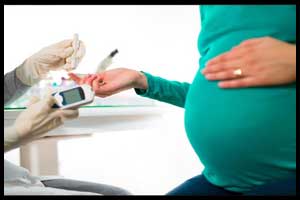- Home
- Editorial
- News
- Practice Guidelines
- Anesthesiology Guidelines
- Cancer Guidelines
- Cardiac Sciences Guidelines
- Critical Care Guidelines
- Dentistry Guidelines
- Dermatology Guidelines
- Diabetes and Endo Guidelines
- Diagnostics Guidelines
- ENT Guidelines
- Featured Practice Guidelines
- Gastroenterology Guidelines
- Geriatrics Guidelines
- Medicine Guidelines
- Nephrology Guidelines
- Neurosciences Guidelines
- Obs and Gynae Guidelines
- Ophthalmology Guidelines
- Orthopaedics Guidelines
- Paediatrics Guidelines
- Psychiatry Guidelines
- Pulmonology Guidelines
- Radiology Guidelines
- Surgery Guidelines
- Urology Guidelines
Contrasting Genetics: Indian Women 2-7 times more likely to get Gestational diabetes than European Counterpart

It is not only the lifestyle but the contrasting impact of the genetics of the Indian population which make Indian women more susceptible to gestational diabetes. A novel study comparing the occurrence of gestational diabetes in Indian and Swedish women has revealed that the odds of getting gestational diabetes is two to seven times higher in Indian women as compared to Europeans and Indian women are on average ten years younger when they develop the disease, they are also leaner and more insulin sensitive. The study was conducted by Lund University Diabetes Centre and was recently published in the Journal of Internal Medicine.
India with its 1.3 billion inhabitants has great genetic differences. People from northern India share similar genetics with individuals from the Middle East, Central Asia, and to some extent Europe, while India's southern population belongs to a more proprietary genetically defined group. The country has the highest number of people with type 2 diabetes in the world and the number is increasing dramatically.
The study includes 507 Swedish women from Malmö and 4,018 Indian women from the state of Punjab. The results have subsequently been replicated in cohorts with 398 women from Finland and 780 from Norway. The diagnosis criteria in Sweden is 10 mmol/l after a two hours glucose tolerance test. To be consistent across all studies, they used the same criteria in all the studies and therefore ended up with a total of 5703 study participants from all studies of whom 274 had gestational diabetes.
"Individuals with Asian origin have two to seven times greater risk of developing the disease compared to Europeans," says Geeti Aurora, a physician in the Indian state of Punjab, and researcher at the Lund University Diabetes Centre who conducted the study in India.
The most shocking finding of the study was out of 85 known gene, one gene was associated with Indians but not with the Swedish population. On the contrary, another gene, CRY2, which is of importance to the circadian rhythm, was found to have a protective effect in Indian women but is associated with increased risk in Swedish women.
"It is interesting that the same gene has the opposite effect in the Indian and Swedish population and the question is whether it can be related to the shifting seasons in Scandinavia which don't occur in India", says Rashmi Prasad.
Gestational diabetes is characterized by impaired insulin production during pregnancy. The prevalence differs between different populations and can partly be explained by lifestyle and genes. The purpose of the study was therefore to investigate the differences between pregnant women in India and Scandinavia.

Disclaimer: This site is primarily intended for healthcare professionals. Any content/information on this website does not replace the advice of medical and/or health professionals and should not be construed as medical/diagnostic advice/endorsement or prescription. Use of this site is subject to our terms of use, privacy policy, advertisement policy. © 2020 Minerva Medical Treatment Pvt Ltd